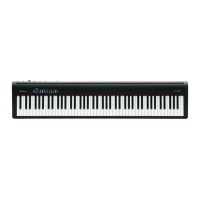MIDI Implementation
21
70104: Isolator
This is an equalizer which cuts the volume greatly, allowing you to add a special
eect to the sound by cutting the volume in varying ranges.
No Parameter Value Description
1
Boost/Cut
Low
0–64 -60–+4 dB
These boost and cut each of
the High, Middle, and Low
frequency ranges.
At -60 dB, the sound becomes
inaudible. 0 dB is equivalent
to the input level of the
sound.
2
Boost/Cut
Mid #1
3
Boost/Cut
High #2
4
Anti Phase
Low Sw
0–1 O, On
Turns the Anti-Phase function
on and o for the Low
frequency ranges.
When turned on, the
counter-channel of stereo
sound is inverted and added
to the signal.
5
Anti Phase
Low Level
0–127 0–127
Adjusts the level settings for
the Low frequency ranges.
Adjusting this level for certain
frequencies allows you to
lend emphasis to specic
parts. (This is eective only
for stereo source.)
6
Anti Phase
Mid Sw
0–1 O, On
Settings of the Anti-Phase
function for the Middle
frequency ranges
The parameters are the same
as for the Low frequency
ranges.
7
Anti Phase
Mid Level
0–127 0–127
8
Low Boost
Sw
0–1 O, On
Turns Low Booster on/o.
This emphasizes the bottom
to create a heavy bass sound.
9
Low Boost
Level
0–127 0–127
Increasing this value gives you
a heavier low end.
Depending on the Isolator
and lter settings this eect
may be hard to distinguish.
10 Level 0–127 0–127 Output Level
70105: Low Boost
Boosts the volume of the lower range, creating powerful lows.
No Parameter Value Description
1
Boost
Frequency #1
0–8 50–125 Hz
Center frequency at which the
lower range will be boosted
2
Boost Gain
#2
0–12 0 –+12 dB
Amount by which the lower
range will be boosted
3 Boost Width 0–2
Wide, Mid,
Narrow
Width of the lower range that
will be boosted
4 Low Gain 0–30 -15–+15 dB
Gain of the low frequency
range
5 High Gain 0–30 -15–+15 dB
Gain of the high frequency
range
6 Level 0–127 0–127 Output level
70106: High Pass Filter
This is a lter with an extremely sharp slope. The cuto frequency can be varied
cyclically.
No Parameter Value Description
1 Filter Type 0–3
Lpf, Bpf, Hpf,
Notch
Filter type
Frequency range that will
pass through each lter
Lpf: Frequencies below the
cuto
Bpf: Frequencies in the region
of the cuto
Hpf: Frequencies above the
cuto
Notch: Frequencies other than
the region of the cuto
No Parameter Value Description
2 Filter Slope 0–2
-12, -24, -36
dB
Amount of attenuation per
octave
-36 dB: Extremely steep
-24 dB: Steep
-12 dB: Gentle
3
Filter Cuto
#1
0–127 0–127
Cuto frequency of the lter
Increasing this value will raise
the cuto frequency.
4
Filter
Resonance
#2
0–100 0–100
Filter resonance level
Increasing this value will
emphasize the region near
the cuto frequency.
5 Filter Gain 0–12 0 – +12 dB
Amount of boost for the lter
output
6
Modulation
Sw
0–1 O, On
On/o switch for cyclic
change
7
Modulation
Wave
0–4
Tri, Sqr, Sin,
Saw1, Saw2
How the cuto frequency will
be modulated
Tri: Triangle wave
Sqr: Square wave
Sin: Sine wave
Saw1: Sawtooth wave
(upward)
Saw2: Sawtooth wave
(downward)
8 Rate Mode 0–1 Hz, note
When this is set to “note,” the
eect is synchronized with
the tempo.
9 Rate 1–127
0.05–10.00
Hz
Rate of modulation (Hz)
10 Rate 0–21 note Rate of modulation (note)
11 Depth 0–127 0–127 Depth of modulation
12 Attack 0–127 0–127
Speed at which the cuto
frequency will change
This is eective if Modulation
Wave is SQR, SAW1, or SAW2.
13 Level 0–127 0–127 Output level
70110: Overdrive
Creates a soft distortion similar to that produced by vacuum tube ampliers.
No Parameter Value Description
1 Drive 0–127 0–127
Degree of distortion
Also changes the volume.
2 Amp Type #1 0–3
Small,
Built-In,
2-Stack,
3-Stack
Type of guitar amp
Small: small amp
Built-In: single-unit type amp
2-Stack: large double stack
amp
3-Stack: large triple stack amp
3 Low Gain 0–30 -15–+15 dB Gain of the low range
4 High Gain 0–30 -15–+15 dB Gain of the high range
5 Pan 0 –127 L64–63R
Stereo location of the output
sound
6 Level #2 0–127 0–127 Output Level
70111: Distortion
Produces a more intense distortion than Overdrive. The parameters are the same as
for “Overdrive.”

